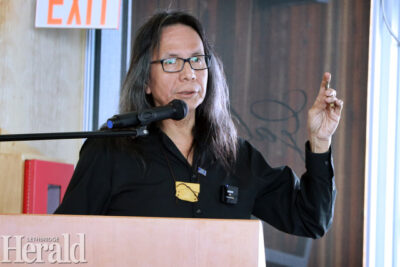Galt honours Earth Day with talk about the decline of native plants
By Steffanie Costigan - Lethbridge Herald Local Journalism Initiative Reporter on April 22, 2023.
 Herald photo by Steffanie Costigan
Api'soomaahka William Singer III, an instructor at Opokaa'sin Early Intervention Society holds a piece of licorice root during a presentation this week at the Galt Museum.
Herald photo by Steffanie Costigan
Api'soomaahka William Singer III, an instructor at Opokaa'sin Early Intervention Society holds a piece of licorice root during a presentation this week at the Galt Museum.The lands hold so much, including the roots of our culture and ancestry. But do we truly understand the natural treasures the lands hold within it, and most importantly, do we appreciate it?
The Galt Museum celebrated Earth Day with a look at Indigenous history in a program called “Water is Life” Thursday morning.
Indigenous guest speaker Api’soomaahka William Singer III, an instructor at Opokaa’sin Early Intervention Society, addressed the audience by explaining the decline of native plants and the mission of Naapi’s Garden.
“Today, we are experiencing a decline in our native plants which leads to a decline in community health, and every plant that we lose will affect our Niitsitapi way of life. Navigating environmental and social climate change requires looking to our history and stories to take action,” Singer said.
He shared a few Indigenous stories, including Iihkitsikamm, The Seven Stars. The stories shared all related back to the lands and the beginnings of the earth. Singer expressed the importance behind these stories and how they have impacted him.
“Those are the lessons I couldn’t really move ahead and do this work without knowing some of these other stories. So, at the phrase, I talk about knowing everything is really important,” he said.
Singer shared the benefits of implementing natural remedies and food can have not only for the people but to the land. He also talked about the harms of current artificial additives in products. He said that knowledge of plants is not something that is common knowledge.
“You know then there are things you can’t find in a book or Google on the internet. You have to put your whole soul into it. So, for myself running Naapi’s Garden its more than that. There is so much more. There is a whole world to do it. For me, it’s something that I enjoy teaching a lot,” shared Singer.
Among the plants mentioned was wild licorice. It is a sweet root that can be used as a toothbrush; Singer held the root of wild licorice the audience to see. He talked about the damage to the land and the responsibility to repair it.
“Everything is placed here by the creator, and we use it. But it’s gotten to that point where we have to do something now. We got to turn around and take care of the earth. Because we are kind of the ones who is destroying that. So, we have to take that initiative,”
Naapi’s Garden welcomes anyone who may be interested in learning and volunteering within the gardens. Singer shared the impact the seed bank will have in the future.
“Who knows how this land is going to be in 10, 15 years from now? The seed bank will be there for them. Those seeds is what is going to heal our people, and that is the work that I am doing, as well. All the foods that are on the land are basically medicine, and teaching the kids that is the importance of them. All my foods are dry. I basically live like my ancestors,” he said.
Naapi’s Garden and Katoyiss Seed Bank is partnered with varying associations, including the Kainai Ecosystem Protection Association, the Kainai Linnii Rematriation Project, the Blood Tribe Land Management, and most recently, Parks Canada Waterton.
14-13


